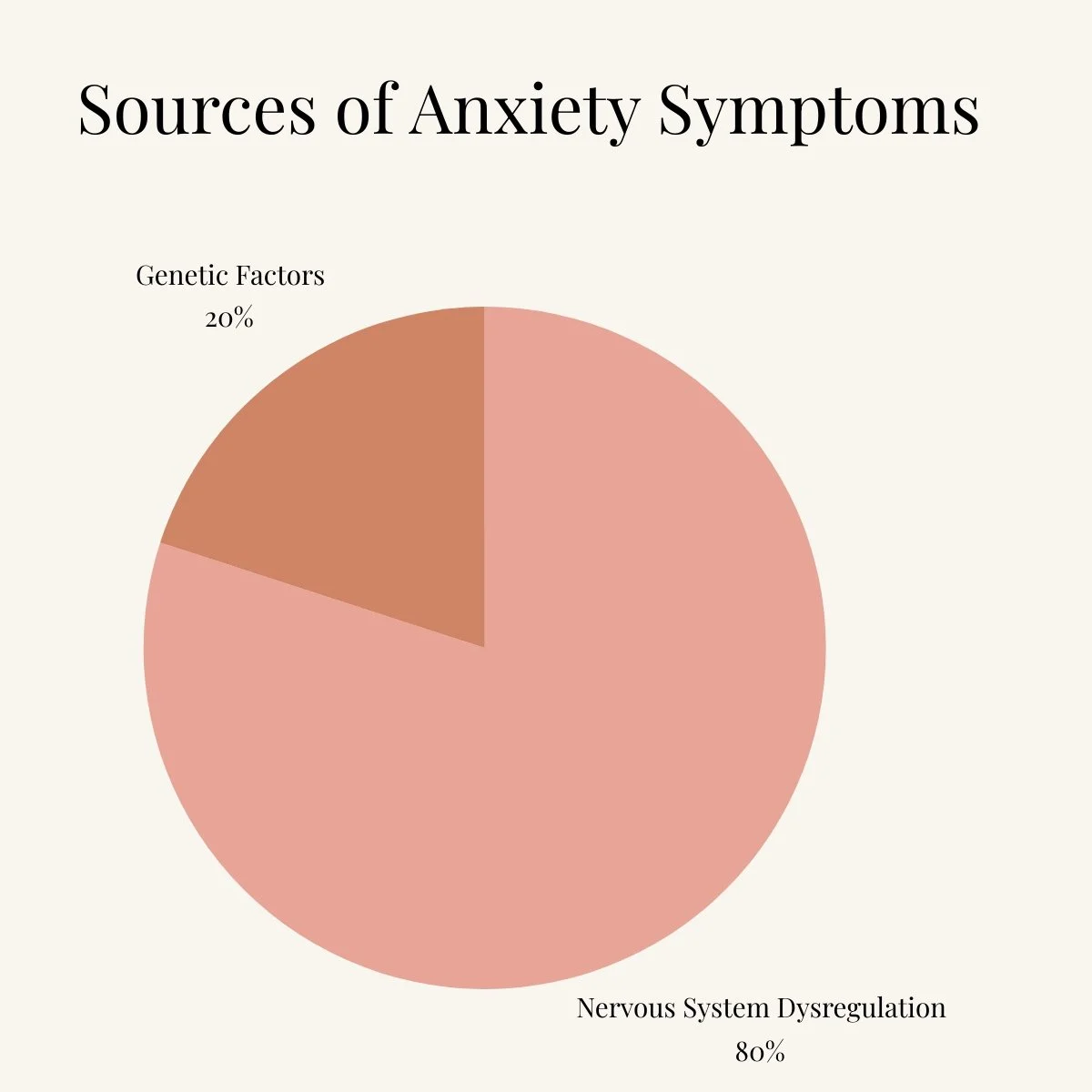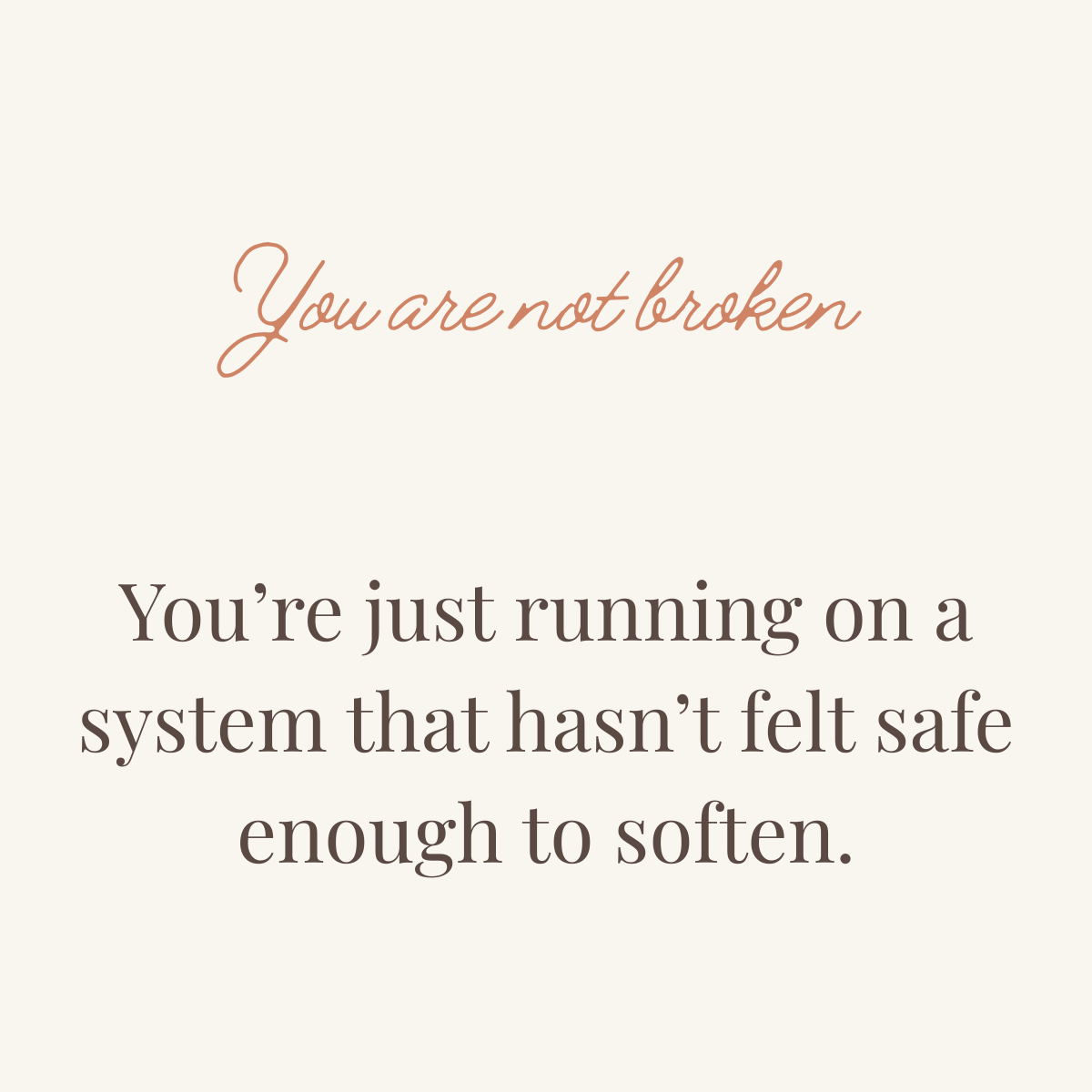What Is Nervous System Regulation?
A Guide to Feeling Safe Being Soft Again
The goal of every high achieving, emotionally exhausted woman I work with is to finally be able to relax—like, actually relax—without guilt or anxiety creeping in.
But with a nervous system that’s been wired for hypervigilance, perfectionism, and performance-based worth since diapers? It can feel impossible to ever reach that soft, safe exhale you’re craving.
You keep trying the rituals you’ve been told will help—meditation, journaling, maybe even a therapy appointment or two—but nothing sticks. You’re still tense, overwhelmed, and secretly asking yourself: Why can’t I relax?
Maybe you’ve been…
Scheduling rest into your calendar like it’s your job, and still feeling guilty about it
Reading about “calming your nervous system” but your jaw is still clenched tight
Wondering if something’s wrong with you because even bubble baths and breathwork don’t work
It can make you feel discouraged, even broken.
But today, you’re in luck—because I’m going to walk you through the gentle, trauma-informed practice of nervous system regulation: what it is, how it works, and how to start applying it even if you’ve never felt emotionally safe before.
🧠 What Is Nervous System Regulation?
Nervous system regulation is the process of helping your body shift out of survival mode—fight, flight, freeze, or fawn—and back into a state of calm, connection, and internal safety.
In short: it’s how your body learns that it’s safe to soften. To be human.
It allows your system to move from:
anxiety → relaxation
overthinking → presence
control → flexibility
And from there, everything starts to change:
You sleep better. You stop spiraling over small things. You stop associating stillness with danger. You actually know what you want. You even feel brave enough to ask for it. You start to feel like yourself again.
🌿 Download now: Stitch by Stitch Free Guide – a beginner-friendly introduction to nervous system rituals using fiber arts.
💡 Why Is Nervous System Regulation Important?
📊 Studies show that up to 80% of chronic stress and anxiety symptoms are rooted in nervous system dysregulation (a fancy psychology term that basically means not ‘calm’ or ‘rested.’ There can be fun dysregulation like a surprise party or not so fun dysregulation like a bad performance review from your boss.)
Anxiety symptoms from nervous system dysregulation look like:
Feeling constantly “on edge” or unable to relax
Difficulty sleeping, even when exhausted
Snapping at people you love over small things
Feeling like rest makes your skin crawl
Without nervous system regulation, your body stays stuck in a loop. You can understand what’s happening logically—but your body still feels like it’s in danger.
By implementing regulation practices, you’ll be able to:
Soothe your anxiety in the moment
Build emotional safety over time
Actually feel relaxed—instead of just performing self-care rituals that don’t land
And here’s the kicker: regulation gives you the ability to access joy, rest, and creativity again.
Without it? You’re just layering routines on top of panic. It’s like trying to clean a car with more mud. You’re trying to “calm down” without ever feeling safe.
✨ Nervous System Regulation Examples
If “regulation” sounds vague or clinical—I get it.
It’s also one of those things that seems simple… until you try to actually do it.
So let’s break it down with a few tasky ways to begin regulating:
Example 1: Rhythmic Crafting (Like Knitting!)
You know I had to start here! And yes - really. Repetition is your nervous system’s love language.
When you knit, your body enters a rhythm that mimics safety:
→ steady hand motion
→ gentle focus
→ tactile feedback
→ consistent left to right movement (bilateral stimulation for all of us science nerds!)
Like rocking a baby to sleep, consistent back and forth movements like walking, swaying, and knitting give your body safe rhythm. Even if it’s imperfect, your body begins to associate that rhythm with “I’m okay.”
🧶 This is what my free guide, Stitch by Stitch, is all about.
Example 2: Sensory Anchors During Stress
Your senses are always bringing gigabytes of data to your brain. And your brain processes all that data in seconds - way faster than your conscious mind could (she’s cute and smart that logic brain, but the somatic brain is faster). The more you engage your senses intentionally, the easier it is to regulate your system.
For example:
Hold something textured in your hands (like yarn, a mug, a rock)
Light a scent that reminds you of comfort
Wrap yourself in a warm or heavy blanket
This works because your nervous system judges sensation more important than thoughts.
Hence why you can think “I should stop being so dramatic about this”, but you still can’t take a deep breath.
Example 3: Self-Paced Rest + Release
The goal of nervous system regulation is to get you from the high intensity tone of your sympathetic nervous system and its survival energy bursts back down to your parasympathetic nervous system (often called your ‘rest & digest’ system).
Signs that you’re coming down from your sympathetic into your parasympathetic are kinda strange. And everyone has their own pace to get there.
Sometimes regulation means letting yourself cry in the bath.
Sometimes it means giving yourself a big stretch to give the anxiety somewhere to go.
Sometimes it means feeling the weight of gravity pulling on your feet.
Sometimes it means having a snack.
The goal isn’t perfection. The goal is repatterning your body’s idea of safety.
🌿 Tips for Nervous System Regulation Success
Here are a few ways to support your nervous system consistently:
1. Start small, stay consistent
You don’t need a whole morning routine. I repeat - you do NOT need a whole 12 step morning routine. Start with one sensory ritual—like drinking tea slowly or knitting for five minutes.
2. Pay attention to what feels good—not what looks good
You’re not “failing” at rest if it doesn’t look like an Instagram reel. And sometimes what helps you feel better yesterday won’t today. That’s normal.
You’re doing it right if your body softens.
3. Switch from discipline to rhythm
The hustle and go discipline bros are entertaining to watch, but don’t know anything when it comes to overtaxed nervous systems. Don’t force a rigid practice. Create a flexible rhythm that your nervous system can rely on.
It’s like swing dancing versus doing the Macarena.
You can perfectly execute the Macarena… but is it dancing?
Swing dancing, especially West Coast swing dancing (I’m OBSESSED with watching videos!), is about taking cues from your partner, listening to the change of the song, and finding a flow that feels good in the moment.
🧵 Start Regulating Today
I hope this guide on nervous system regulation for anxiety has been helpful! If you take anything away, remember this:
The best way to build emotional safety is to start small—with one ritual, one anchor, one moment of softness. That’s how you teach your body to feel safe being you again.
✨ [FREE DOWNLOAD]
Stitch by Stitch: Nervous System Rituals for Softness, Safety, and Self-Trust
Want to try a cozy, creative way to regulate? This free guide walks you through fiber arts-based rituals that calm your nervous system—without performance, pressure, or meditation.
🧶 Includes a breakdown of the science of knitting for your nervous system, 3 guided patterns so you can practice regulating and crafting simultaneously,, and a cute-as-a-crocheted-button affirmation to keep with you.
📥 Click here to download Stitch by Stitch now



